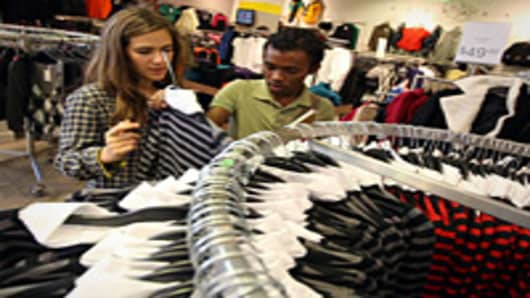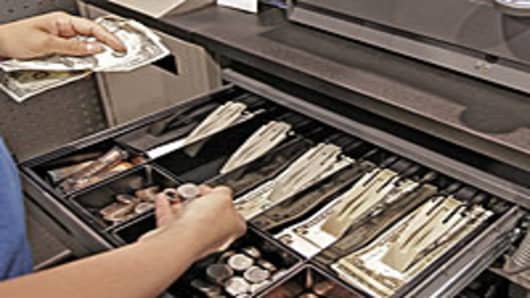The economy has struck a soft patch that is likely temporary, and the second half of the year should be better, some economists say.
Supply chain disruptions form the Japanese earthquake and tsunami have had a direct impact on manufacturing and the auto industry in particular. Additionally, the spike in oil and gasoline prices has hit consumer and business spending.
"We can put our finger on the problems, and they're temporary, I think," said Mark Zandi of Moody's Economy.com. "Oil prices were a blow. You can see that in the consumer spending numbers in Q1, and prices are coming back down."
Friday's sharp 11.6 percent decline in April pending home sales was among the latest in a string of disappointing economic reports. Consumer spending was also softer in April, up just 0.4 percent, the smallest amount in three months.
But consumer sentiment, also reported Friday, was a positive surprise. Overall sentiment rose to 74.3 in May from 69.8 in April, but it is still below February's 77.5.
Other soft data this past week includes the second look at first quarter GDP, still a sluggish 1.8 percent, while economists had expected it to rise above 2 percent.
J.P. Morgan economist Michael Feroli expects second quarter GDP to be nearly as weak as the first quarter, but he expects the second half of the year to climb to 3 percent.
"Right now, we have 2.5 percent (for second quarter) but with significant downside risk...I think you should get some rebound in the third quarter, the second half more generally. Gasoline prices easing off does remove a big burden. You should get a bounce in industrial activity when he Japanese-related activity comes back," he said.
Zandi and other economists do not expect to see a strong showing in May employment data, reported next week. Zandi has dropped his expectation for non-farm payrolls to under 200,000, well below April's 244,000.
Weather has had some impact on weekly jobless claims data, and the auto shutdowns have also been a factor. The rise in unemployment claims - above 400,000 for the past seven weeks - suggest the rate of hiring is slowing.
"All these sort of things kind of sapped some of the growth, and that will be reflected in the jobs number. We had been getting a fair amount of growth in manufacturing...I think that will be on the soft side because of the quake," he said.
Zandi said there are some wild cards that could hurt the economy, such as the decline in real estate prices, the sovereign debt issues in Europe or another spike in oil prices. "I think it would be worrisome if they didn't help the Greeks, and the Greeks restructure their debt. That would be a default. That would be a kind of Lehman moment for Europe," he said.
Goldman Sachs economists this week shaved their outlook for second quarter growth to 3 percent from 3.5 percent. Their original forecast had been for 4 percent second-quarter growth.
Goldman Sachs economists Andrew Tilton said the ripple effect from supply chain issues were a big part of the reason for the reduction. "We estimated it was a bit more than a half a point off Q2 growth. That doesn't explain all the weakness relative to our original forecast. There are other things going on, the most obvious of which is oil prices," he said.
Tilton said a jump in gasoline prices can have a meaningful effect on consumers within a quarter. "If oil is coming back down you certainly wouldn't want to be cutting your growth forecast for the second half of the year," he said.
Gasoline experts are forecasting the decline in retail gasoline prices that have been underway for nearly two weeks will continue. The national average at the pump Friday was $3.80 per gallon, down from a year high of $3.98 per gallon on May 13, according to AAA.
"In so far as you think it's supply chain-related, the deeper the cutback due to supply chain factors now, the better you should feel about second half because it should bounce back," said Tilton.
Pimco CEO Mohamed El-Erian, however, expects the second half to be weak, and he sees this year following the same pattern as last year. But last year, when the economy weakened, it was supported by fiscal stimulus and the Fed's quantitative easing program and neither are likely this year.
"The good news is the possibility of a double dip is much lower," he said in a brief interview.
RBS chief economist Michelle Girard had been expecting a soft second quarter, and it is slightly weaker than she had expected. "The consumer is a bit more constrained because of the run-up in gasoline in March and April," she said.
But she still sees a better second half.
"I still think the second quarter is giving us the disappointment I feared would occur. The important thing is I still have not changed the second-half outlook. We still feel the second half will show the acceleration. I feel just as good about that as I did before. I think the decline in gasoline prices bodes very well for the consumer. On the supply disruption, everybody is anticipating that we get a ramp-up in production for (what) was lost. There's no indication that the auto industry is rethinking the bigger picture," she said.
Girard cut her forecast for the second quarter recently to 2.7 percent from 3 percent, but she expects 4 percent growth for the second half.
Zandi said one positive is the fact that interest rates have fallen recently. "Mortgage rates are 4.6 percent, so refinancing activity is going to pick up again," he said.
"I think the underlying dynamics are positive and there are ebbs and flows, and right now we are ebbing," said Zandi.
Questions? Comments? Email us at marketinsider@cnbc.com




